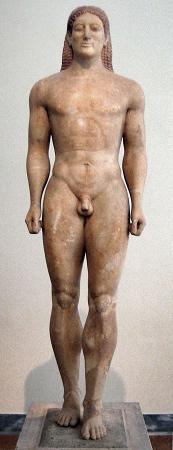Kouros. A kouros is the modern term given to free-standing ancient Greek sculptures that first appear in the Archaic period in Greece and represent nude male youths. In Ancient Greek kouros means youth, boy, especially of noble rank. Although Kouroi have been found in many ancient Greek territories, they were especially prominent in Attica and Boiotia. The term kouros was first proposed for what were previously thought to be depictions of Apollo by V. I. Leonardos in 1895 in relation to the youth from Keratea, and adopted by Henri Lechat as a generic term for the standing male figure in 1904. Such statues are found across the Greek-speaking world; the preponderance of these were found in sanctuaries of Apollo with more than one hundred from the sanctuary of Apollo Ptoion, Boeotia, alone. These free-standing sculptures were typically marble, but the form is also rendered in limestone, wood, bronze, ivory and terracotta. They are typically life-sized, though early colossal examples are up to 3 meters tall. The female sculptural counterpart of the kouros is the kore. In Ancient Greek kouros means youth, boy, especially of noble rank. When a pubescent was received into the body of grown men, as a grown Kouros, he could enter the initiation fest of the brotherhood. Apellaios was the month of these rites, and Apollo was the megistos kouros. The kouros type appears to have served several functions. It was previously thought that it was used only to represent the god Apollo, as attested by its depiction on a vase painting in the presence of supplicants. This association with Apollo was supported by the description of the statue of the Pythian Apollo at Samos by Diodoros as Egyptian in style, with his arms hanging by his sides and his legs parted. However, not all kouroi are images of a deity; many have been discovered in cemeteries where they most likely served as commemorative tombstones of the deceased, also the type was used as a memorial for victors in the games, kouroi were used as offerings to the gods, and some kouroi have been found in sanctuaries other than that of Apollo. Indeed, some kouroi placed in sanctuaries were not inscribed with the name of the god but with a mortal, for example the 'Delphi Twins' Kleobis and Biton were honoured for their piety with matching kouroi. A direct influence between Egyptian sculptures and the kouros type has long been conjectured, not least because of trade and cultural relations that are known to have existed since the mid-seventh century BCE. A 1978 study by Eleanor Guralnick applied stereophotogrammetric measurement and cluster analysis to a number of Greek and Egyptian statues and found the correlation between the Second Canon of the 26th Dynasty and Greek kouroi to be widely distributed but not universal. The problem of the evolution of the kouros type is inevitably linked to that of the overall development of monumental Archaic Greek sculpture. There are fundamentally two schools of thought on how those Daedalic forms, some of which we know of only from the literature, became the free-standing sculpture in the round of the 6th century; namely, that it was a response to the internal development of Greek types and religious needs or a product of foreign influence. For an external cause for change possible sources of influence have been cited as Egypt, Anatolia and Syria, with the strongest case made for Egypt. It is known that the Greeks had longstanding trade relations with Egypt prior to the founding of the Greek entrepot of Naukratis in the mid-7th century from where the Greeks could have learned Egyptian sculpting methods. The work of Guralnick along with the previous studies by Erik Iversen and Kim Levin have added considerably to the argument for an imitation by Greek sculptors of Egyptian sculpture. The system of proportion in the second Egyptian canon of the Saite period consisted of a grid of twenty-one and one fourth parts, with twenty-one squares from the soles of the feet to a line drawn through the centres of the eyes. The grid was applied to the surface of the block being carved, allowing the major anatomical features to be located at fixed grid points. Iversen has shown that the New York kouros conforms to this ratio of proportion. It was Guralnick, however, who developed this discovery by comparing other kouroi by means of cluster and Z-score profile analysis to the Egyptian Canon II and a control group composed of statistically average Mediterranean men. As a result, she has identified two strains within methods of proportioning in sixth century kouroi, where the majority follow the general line of evolution from the foreign model towards an idealized human norm. Kouroi are beardless, take a formulaic advancing posture, and are most often nude.
more...




